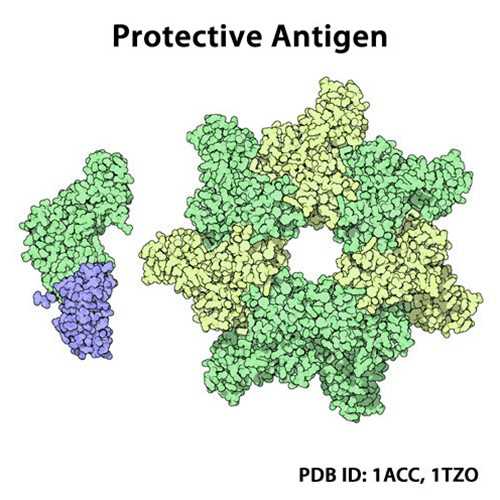PA L687A (Anthrax Protective Mutant Antigen (PA-L687A))
The L687A mutant protective antigen (PA) binds preferentially to the CMG2 receptor vs. the TEM8 receptor.
Anthrax toxin is a three-protein exotoxin secreted by virulent strains of the bacterium, Bacillus anthracis, the causative agent of anthrax. Anthrax toxin is composed of a cell-binding protein, known as protective antigen (PA), and two enzyme components, called edema factor (EF) and lethal factor (LF). Anthrax is caused by B. anthracis, a spore-forming, Gram positive, rod-shaped bacterium. The lethality of the disease is caused by the bacterium's two principal virulence factors: the polyglutamic acid capsule, which is anti-phagocytic, and the tripartite protein toxin, called anthrax toxin.
From the laboratory of Stephen H. Leppla, PhD, National Institute of Allergy and Infectious Diseases/NIH.
The L687A mutant protective antigen (PA) binds preferentially to the CMG2 receptor vs. the TEM8 receptor.
Anthrax toxin is a three-protein exotoxin secreted by virulent strains of the bacterium, Bacillus anthracis, the causative agent of anthrax. Anthrax toxin is composed of a cell-binding protein, known as protective antigen (PA), and two enzyme components, called edema factor (EF) and lethal factor (LF). Anthrax is caused by B. anthracis, a spore-forming, Gram positive, rod-shaped bacterium. The lethality of the disease is caused by the bacterium's two principal virulence factors: the polyglutamic acid capsule, which is anti-phagocytic, and the tripartite protein toxin, called anthrax toxin.
From the laboratory of Stephen H. Leppla, PhD, National Institute of Allergy and Infectious Diseases/NIH.
In order to purchase this product, we require a Letter of Assurance form to be completed. Download form here: ![]() Kerafast Letter of Assurance
Kerafast Letter of Assurance
| Product Type: | Protein |
| Name: | L678A |
| Alternative Name(s): | PA L687A |
| Accession ID: | P13423 |
| Strain: | Expressed in avirulent engineered B. anthracisstrain BH445 |
| Format: | Purified protein (liquid) |
| Purity: | Q-Sepharose Ion Exchange Chromatography |
| Buffer: | 5 mM Hepes pH 7.5, 0.50 mM EDTA |
| Concentration: | 6.24mg/mL |
| Storage: | -80C |
| Shipped: | Dry ice |
- Leppla SH. Production and purification of anthrax toxin. Methods Enzymol. 1988;165:103-16.
- Liu, S., Zhang, Y., Moayeri, M., Liu, J., Crown, D., Fattah, R. J., Wein, A. N., Yu, Z. X., Finkel, T., and Leppla, S. H. (2013) Key tissue targets responsible for anthrax-toxin-induced lethality. Nature 501, 63-68
If you publish research with this product, please let us know so we can cite your paper.


